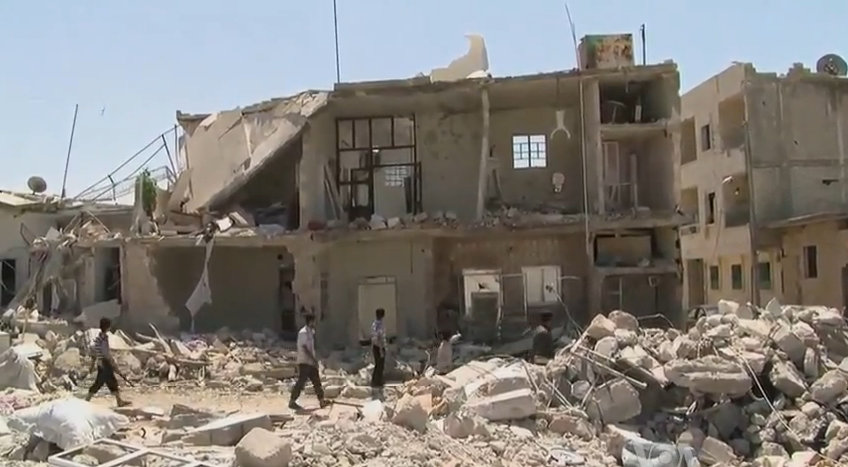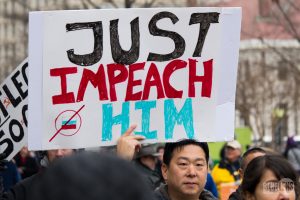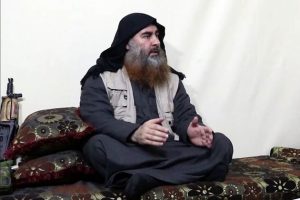by Mark N. Katz
The conflict in Syria was very much the focus of international diplomacy and attention from the time of its outbreak at the onset of the Arab Spring in 2011 until the beginning of the Ukraine crisis in early 2014. Since Russia seized Crimea from Ukraine in early 2014 and then later supported separatist rebels in eastern Ukraine, however, the conflict in Ukraine has overshadowed the one in Syria. Due to the rise of the Islamic State (ISIS or IS) both in Syria and Iraq, though, the conflict in Syria remains extremely serious—and, indeed, will likely prove the more difficult problem to resolve.
Both conflicts have certain similarities. One is that Russia is playing an important role in both conflicts. Although it supports the government’s efforts to combat the rebels in Syria, Moscow is supporting the rebels fighting against the government in Ukraine.
Both conflicts have wider spillover potential. Indeed, the conflict in Syria has already spilled over into Iraq, and threatens to (further) engulf Lebanon, Jordan, and perhaps other Middle Eastern states. The conflict in Ukraine has so far been confined to the territory of that country. But Moscow’s intervention to “protect” Russian speakers there could presage similar Russian efforts elsewhere—including in the Baltic states, which are members of both NATO and the EU.
Each conflict has primacy in its particular region. Europeans are more concerned about the conflict in Ukraine out of fear that it could spill over into other parts of Europe. Middle Easterners, by contrast, are more worried about the conflict in Syria out of fear that it could spill over into other parts of the Middle East.
The Obama administration has limited its involvement in both conflicts. In Ukraine, the U.S. has ceded leadership of the Western diplomatic effort to Germany and France to reach a negotiated end to the conflict with Russia and with the Russian-backed rebels. In Syria, U.S. forces have been involved in bombing IS targets both there and in Iraq. The U.S., though, seems to have lost interest in the diplomatic effort to bring about a negotiated settlement between the Assad regime and its increasingly weak “moderate” opponents. Washington is giving some assistance to these groups in Syria, but is not giving any lethal assistance to Kiev.
There is one especially important difference between the two conflicts: while the primary international dimension of the one in Ukraine is Russia versus the West, this is not the case in Syria where the primary international dimension is Iran versus the Sunni Arabs. What this suggests is that if Russia and the West could actually agree to end the fighting in Ukraine, they could each cajole their Ukrainian allies to go along with them. In Syria, however, any agreement between Russia and the West on ending the conflict could have very little impact either on the main regional adversaries involved there (Iran on the one hand and the Gulf Arab states on the other) or on the main local adversaries (the Assad regime on the one hand and IS and the al-Nusra Front on the other)—especially given the apparent marginalization of the moderate Syrian opposition.
This also suggests that the more absorbed in the Ukrainian conflict that Russia and the West become, the less willing and able they will be to cooperate in bringing about a negotiated solution to the Syrian conflict—which will, in turn, give greater latitude for local and regional actors there. And these actors on the ground do not seem inclined to resolve it peacefully.
This is not to say that the conflict in Syria could have been successfully brought to an end if the conflict in Ukraine had not erupted. Fighting had been going on in Syria for three years before the Ukrainian conflict began. But although Russia and the West have very different views on whether Bashar al-Assad should remain president of Syria, their common opposition to the rise of IS gave them an important common interest regarding Syria—one which they have not been able to work on effectively due to their growing differences over Ukraine.
The conflict in Ukraine could come to an end if Vladimir Putin decided that it was in his interests to end it (the West would certainly not push for it to continue). By contrast, there is no one person whose decision could end the conflict in Syria. As bad as the conflict in Ukraine is, then, the one in Syria appears to be the more intractable as well as more likely to spread. Indeed, although the conflict in Ukraine has not spread to the Middle East, the conflict in Syria has already spread into Europe both in the form of the recruitment of young Europeans to join the ranks of IS in Syria and of IS-inspired assassinations in France, Belgium, and Denmark.






“The U.S., though, seems to have lost interest in the diplomatic effort to bring about a negotiated settlement between the Assad regime and its increasingly weak “moderate” opponents.”
The word “regime” is a giveaway to bias here. Actually, the US has never supported a role for President Assad in negotiations, and has instead supported various bogus absentee “governments” (and fighting groups) of Syria, none of which had any support in Syria.
“bringing about a negotiated solution to the Syrian conflict”
It’s a Gulf- and US-supported terrorist fight against an established government, largely non-negotiable, and again the US has failed as in so many other countries. With US-spawned ISIS it has grown, giving Iran yet another opportunity to spread its influence, thanks to the US.
“the primary international dimension of the one in Ukraine is Russia versus the West”
It is not Russia vs. the West, it is Russia responding to the US-instigated coup against a democratically-elected government in Kyev over a year ago, which is not mentioned. The US- and fascist-backed coup on Russia’s doorstep is not mentioned! And the West is well-represented by Germany and France negotiating with Russia, with a current ceasefire which seems to be holding.
Although I also find some resemblance between these two conflicts I would suggest that we shouldn’t overstate the level of Russian engagement in Ukranian crisis. I am convinced that there are forces in the pro-Russian part of Ukraine which do not completely answer to the Russian party. Apart from the fact that the inhabitants of “Novorossia” are more ideologically driven (since their right to use their mother tongue as the official language of their country was questioned) they still have pressing economic problems related to the association with the EU. These reasons will still compel people to act against Ukrainian government for some time, even if Russia ceases to be involved in the conflict. There are also people who will sponsor the continuation of the conflict pursuing their own interest and the people who will be ready to fight at the front for a modest wage, because there is no other choice. Let me explain why. The EU is not ready to buy end-products from Ukraine, since most of them do not match European standards. I want to draw your attention that in spite of the fact that the head offices of many Ukrainian companies are hosted in Kiev, the main production facilities are located in such cities as Kharkov, Lugansk, Mariupol – which is Eastern Ukraine. Take for instance the largest Ukrainian confectionery company Roshen – all factories are located in the southeast, and the head is in Kiev. So who do you think would be more affected if these factories will shut down because they will be deprived of Russian market?
Under the agreement on the Association with the EU, the only thing that the latter is actually willing to buy from Ukraine is raw materials – generally speaking grain and coal. Although the EU is determined to reduce export fees for that type of products, most of them are going to be represented on European market within quite modest quotas. For example, before the Association Agreement is signed the quota on grain export from Ukraine to Europe is over 2,378,000 tons per year. Whereas according to the Association agreement it would consist of less than 950 000 tons per year. Here we take into account that neither confectionery nor clothing and other consumer products that Ukraine used to supply the Russian market with will no more be exported anywhere.
From the winter of 2013 a decree “On measures to improve the state of the military-technical policy” was approved in several readings, and in August 2014 it was signed by the Ukrainian President. According to this decree the President Poroshenko ordered to take measures “to stop exports of military and dual-use equipment to the Russian Federation”.
Here we must understand that considering the engagement of the western part of Ukraine, except, perhaps, Lviv and Vinnitsa in the military industrial complex of Ukraine we can see that they are largely specialized on developing software, forecasting, analysis and regulatory documentation – which are activities designed to military engineering. Whereas the eastern part of the military-industrial complex of Ukraine (Kharkov, Lugansk, Chuguyiv, Zaporozhye) sharpened on series production of aircraft turboshaft engines, armored equipment, Soviet / Russian multi-purpose helicopters – which are the equipment oriented on exports to Russian market. If Novorossia will agree to associate with the EU and recognize the current Ukrainian government as being legitimate, than a bigger chunk of people will lose their jobs.
As for funding the conflict, there are people who is ready to protect their investments in the south-east territory and who would be happy to seize the state assets as a bonus. For example, the Kharkiv region provides about 6% of the total GRP of all regions of Ukraine. Almost all the major assets located in Kharkov are owned by the state (Kharkov factory transport engineering, Malyshev, “Electrotyazhmash” Kharkov Aviation Plant, “Turboatom”), an exception would be only the industrial commodity markets of “Barabashovo” which is owned by Alexander Feldman. Donetsk region accounts for about 12.5% of the gross regional product of Ukraine (it is the second result after Kiev). 200 largest Ukrainian companies are registered in Donetsk which are “Metinvest” of Rinat Akhmetov, “Industrial Union of Donbass” of Sergei Taruta and Oleg Mkrtchyan, “Donetskstal” of Russian businessman Viktor Nusenkis etc. Do you think they might be interested to collaborate with Russian business and acquiring the government property at a little cost?
I’m not giving up the idea that Russia clearly has interests in this part of Ukraine, but I think the Russian factor is not the only facet that triggers militancy in the eastern Ukraine….
Interesting comments to a post that has a slant away from reality. Pundits only see what they want to see, which often isn’t a complete picture. Because of their past prognostications on what ever subject they preach, they tie themselves a viewpoint that may be one sided, i.e., not objective, but only to their level of facts. Today, excepted facts are being shredded by the vast expanse of knowledge available. Tunnel vision may be an apt description.